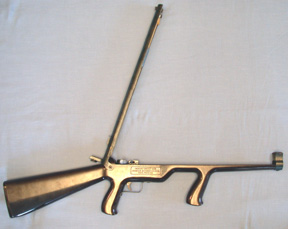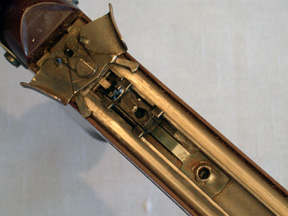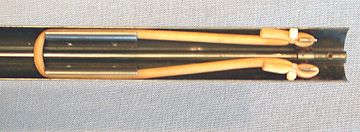by B.B. Pelletier
Today’s strange airgun sold in the late 1940s and early 1950s. A batch of them must have gone unsold, because they reappeared new-in-the-box at airgun shows in the mid-1990s. You can still find one or two at airgun shows, but the piles that were available 10 years ago have disappeared. I’m referring to the Johnson catapult gun.

The Johnson Target Gun is a handsome, adult-sized BB gun.
New in the box – but don’t expect much of the box, itself!
Johnsons were packaged in an acidic pasteboard box that deteriorates over time. I have seen more than 20 new-old-stock examples, and all had decomposed into paper trash. Inside the box, a thin cheesecloth curtain hangs as a backstop. It’s deteriorated, too. Therefore, don’t judge the gun by the condition of the box!
The gun is fascinating!
The Johnson gun is a fascinating study in the toymaker’s art of the 1940s. The materials used were stamped steelplate and plastic. Though plastics were in their infancy in that day, Johnson apparently picked the right ones because they don’t deteriorate nearly as much as the early Daisy plastic stocks.
I could write a book about the design of this gun, but here are just a few highlights. The rear sight is a peep, the front is a windage-adjustable post – just like several military rifles! The “ears” that protect the front sight are spring retainers that allow the top cover to be lifted. That gives access to the mechanism. The gun is a repeater! A long tube of real steel BBs feeds one at a time into the plastic shot carrier for launch. The trigger would embarrass half the adult airguns on today’s market – it’s that good. Of course, there is absolutely no consideration for a safety.

Top cover flips up for access to the mechanism.

Looking down at the BB carrier.
The two “wings” are levers to assist cocking.

Here is a shot of the rubber band installed correctly.
It uses surgical tubing
Instead of regular rubber bands, a Johnson needs something with a lot more stretch. Medical rubber tubing is perfect. Above is the installation on my gun in case you have to do the job.
How much power?
The gun was made during a time when accuracy was favored over power. My Johnson gets 101 f.p.s. with steel BBs. While that is very slow, I can pick off a fly at 12 feet, which is what this gun was designed to do. Velocity varies by no more than 2 f.p.s. Accuracy lets you hit baby asprin at 10 feet with every shot!
How expensive?
Brand new in 1949, a Johnson sold for $15 – when a Daisy number 25 pump was selling for just $6.50. That probably aided the demise of the Johnson. Today, you can find a complete and functioning gun at an airgun show for $50 to $75. A good one in a tattered box brings $100 to 150. The Blue Book of Airguns, 5th edition lists them for $40 to 100, plus another $20 for the box.
If you like unusual airguns, the Johnson belongs on your shopping list.
i was shearching around for ay PCP rifle…im new to it but i own a couple of springers, co2, and pumps rifles…and i wanted to purchase an “BSA techstar” PCP rifle cuz the price is right to fit my budget…and i live in FL and i dont know many scuba shops around here…and i was looking at some of your pumps for PCP rifles like the LOGAN hill pump i think it was…and i was wondering if i can use it ? will it fit the techstar…or do i need to buy an special adapter for it? well i dont know but i need help on it…well later thanks hope you can help me out
I don’t know how you did it, but you have stumbled on the ONLY way to fill the Tech Star! The Tech Star needs 235 bar of air pressure and only the Hill pump can go that high! A scuba tank with that rating would be very expensive!
As far as an adaptor goes, yes, you need a specific adaptor for this gun. Make sure you get EVERYTHING you need from the dealer who sells the gun and pump. The Tech Star is not a mainstream PCP, so you better use a good dealer who has a reputation for after-sales support.
Good luck with your purchase. I hope you enjoy the world of PCP airguns.
B.B.